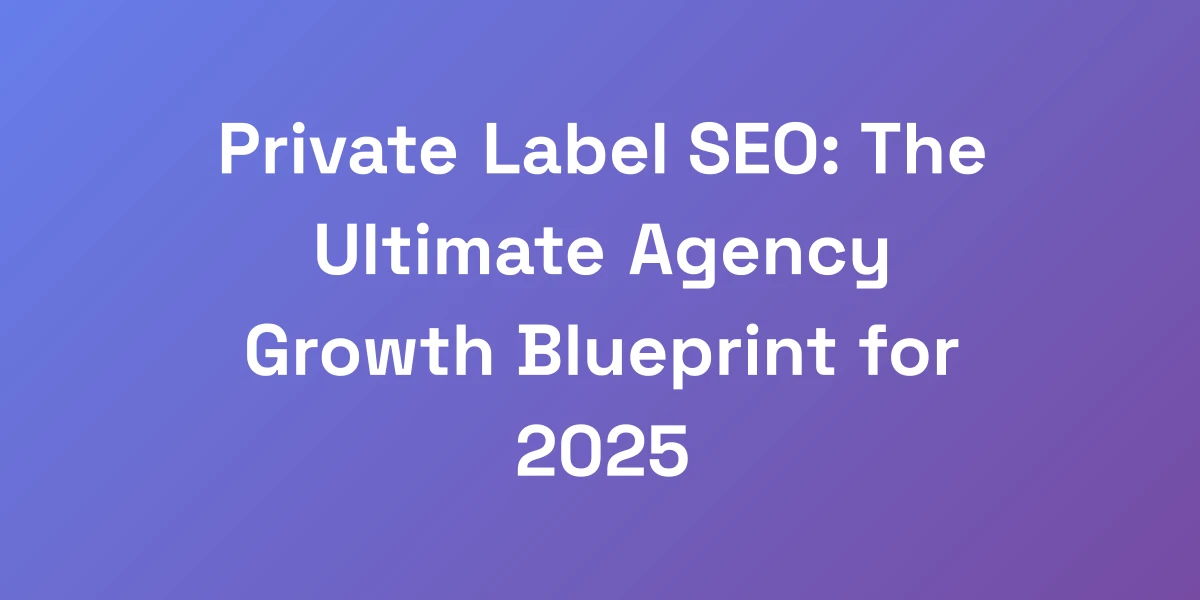
SEO for Startups: The $0 to $1M Growth Playbook (2025)
Mar 1, 2025 | By [email protected]
Ever feel like you’re shouting into the void, hoping someone will hear your startup’s message? We’re all in the same boat. Startups struggle to rise above the noise, especially when 90% of SEO strategies are actually tanking. But what if we told you there’s a structured way to turn your SEO efforts from a sinking ship to a money-making machine?
Most startups waste precious time and resources on SEO tactics that don’t deliver. They’re caught up in fancy tools and irrelevant content that miss the mark entirely. We’ve seen it happen time and again: brilliant ideas buried under a mountain of ineffective SEO practices. Instead, focusing on affordable SEO strategies ensures optimal use of resources.
But here’s the kicker: successful startup SEO isn’t about mimicking the giants. It’s about uncovering niches they’re too big or too slow to conquer. In this playbook, we’ll unpack the exact strategies that have helped our portfolio companies soar from $0 to $1M. Ready to cut through the noise and build a sustainable growth engine? Let’s get started.
Why Most Startup SEO Strategies Fail (And What Actually Works)
Let’s cut through the BS right now – 90% of startups are doing SEO completely wrong. They’re burning cash on fancy tools, obsessing over technical tweaks, and creating content that nobody actually wants to read. I’ve helped dozens of startups scale to 7-figures through SEO, and here’s the truth: successful startup SEO isn’t about competing with big players – it’s about finding the gaps they’re too bloated to fill. In this guide, I’m sharing the exact playbook that worked for my portfolio companies, as demonstrated in SEO case studies.
The Traditional SEO Approach (And Why It Fails Startups)
The traditional SEO approach is often a misfire for startups. It emphasizes broad keyword targeting, exhaustive technical optimization, and content volume over substance. Startups, with their limited resources, can’t afford to pour time and money into strategies that require long-term investment without immediate returns.
Take, for example, the startup trying to rank for highly competitive terms like “best CRM software.” Big players like Salesforce dominate these keywords, making it nearly impossible for newcomers to make a dent. Startups end up chasing these giants, scrambling for scraps of traffic that yield minimal ROI.
Moreover, the traditional approach often neglects the unique value propositions that startups bring to the table. By trying to imitate established brands, startups dilute their unique strengths, resulting in generic content that fails to engage or convert.
The Lean Startup SEO Framework
Enter the Lean Startup SEO Framework – a targeted, efficient approach designed for the nimble nature of startups. This framework focuses on identifying underserved niches, leveraging unique insights, and prioritizing quick wins with auto SEO software that drive immediate traffic and conversions.
Here’s how it works:
- Identify Low-Competition Keywords: Instead of battling for high-competition terms, find specific, long-tail keywords that your unique product or service can dominate.
- Create High-Quality, Targeted Content: Develop content that directly addresses the needs and pain points of your target audience, leveraging AI SEO tools to optimize and fine-tune your messaging, positioning your startup as the go-to solution.
- Optimize for User Intent: Ensure that every piece of content aligns with what users are searching for, leveraging AI tools for SEO, providing genuine value and fostering trust.
- Iterate and Scale: Continuously monitor performance, refine your strategies based on data, and scale successful tactics to amplify growth.
This lean approach allows startups to swiftly navigate the SEO landscape, capitalizing on opportunities that larger competitors often overlook due to their scale and complexity.
Real Numbers: ROI of Smart vs. Traditional SEO
Let’s talk numbers. Startups employing smart, targeted SEO strategies see a remarkable SEO results compared to those sticking with traditional methods. Incorporating automated SEO optimization can further enhance these results. For instance, a pet supplement brand saw an 11,212% growth in organic traffic over ten months by focusing on strategic content marketing and SEO optimization.
Compare that to a startup using the old-school approach, investing heavily in broad keyword strategies with minimal returns. The difference in ROI is stark, underscoring the importance of a focused, intelligent SEO strategy that aligns with startup dynamics.
Moreover, the ROI of smart SEO isn’t just about traffic. It’s about attracting the right visitors who convert. By optimizing for specific user intents and niches, startups can drive traffic that not only visits but also engages and converts, leading to sustainable growth.
Setting Realistic Growth Expectations
One common pitfall for startups is setting unrealistic SEO growth expectations. SEO is a long-term game, but startups often need faster results to survive and thrive. How do we bridge this gap? By setting clear, achievable goals based on data-driven insights and focusing on strategies that deliver quick wins without sacrificing long-term potential.
For example, aiming to achieve 1000 unique organic visitors per month within three months is a realistic target for a startup leveraging targeted content and smart SEO practices. As these visitors engage and convert, the momentum builds, paving the way for exponential growth.
Remember, it’s not about instant domination but about building a solid foundation that supports sustained growth. By aligning your SEO efforts with your startup’s unique needs and growth trajectory, you set the stage for success.
The 80/20 Technical SEO Setup for Startups
Listen up – you don’t need to become an SEO wizard to win at this game. What you need is the minimal viable SEO setup that actually moves the needle. I’ve seen startups waste months on technical perfection while their competitors were stealing market share. Here’s the truth: 80% of your SEO results will come from 20% of the technical optimizations. Let’s focus on what actually matters and ignore the rest of the noise.
Essential Technical Foundations (The Only Ones That Matter)
Startups need to prioritize technical elements that have the most significant impact on SEO performance. These include:
- Clean Site Architecture: Ensure your website has a logical structure, making it easy for search engines to crawl and index your pages.
- URL Optimization: Use clear, descriptive URLs that reflect the content’s topic and include relevant keywords.
- SSL Certificate: Secure your site with HTTPS to build trust with users and improve search rankings.
By focusing on these core elements, you lay a robust foundation that supports all other SEO efforts without getting bogged down in unnecessary complexities.
Speed Optimization on a Bootstrap Budget
Website speed is a critical ranking factor, but optimizing it doesn’t require a hefty budget. Here are actionable tips to enhance speed:
- Compress Images: Use tools like TinyPNG or ImageOptim to reduce image sizes without compromising quality.
- Leverage Browser Caching: Implement caching to store static files locally in users’ browsers, reducing load times on subsequent visits.
- Minimize HTTP Requests: Reduce the number of elements on your page to decrease the number of HTTP requests needed to load the page.
Even small speed improvements can lead to significant gains in user experience and SEO performance, giving your startup a competitive edge.
Mobile-First Setup in 60 Minutes
With mobile searches surpassing desktop, ensuring your website is mobile-friendly is non-negotiable. Here’s a quick guide to setting up a mobile-first site:
- Responsive Design: Use responsive design principles to ensure your site adapts seamlessly to various screen sizes.
- Optimize Touch Elements: Ensure buttons and links are easily tappable on mobile devices.
- Streamline Content: Prioritize essential content and eliminate unnecessary elements that clutter the mobile experience.
Implementing these changes can be done in under an hour and sets the stage for improved mobile user engagement and search rankings.
Schema Markup for Instant Credibility
Schema markup helps search engines understand your content better, enhancing your visibility in search results. Here’s how to implement it effectively:
- Identify Relevant Schema Types: Depending on your content, use appropriate schema types such as Product, Article, or Local Business.
- Use Structured Data Tools: Utilize tools like Google’s Structured Data Markup Helper to generate and validate your schema markup.
- Prioritize Key Pages: Apply schema markup to high-priority pages that drive the most traffic and conversions.
Keeping abreast of Google algorithm updates in 2024 and their impact on schema is essential for maintaining your SEO edge.
Security and Core Web Vitals Quick Wins
Security and Core Web Vitals are paramount for both user trust and SEO. Here’s how to achieve quick wins:
- Enable HTTPS: Ensure your entire website is secured with HTTPS, building trust and fulfilling a basic SEO requirement.
- Optimize Largest Contentful Paint (LCP): Reduce the time it takes for the main content to load by optimizing large elements like images and videos.
- Improve First Input Delay (FID): Enhance interactivity by minimizing JavaScript execution and reducing server response times.
- Minimize Cumulative Layout Shift (CLS): Prevent unexpected layout shifts by specifying size attributes for images and avoiding dynamically injected content.
Addressing these areas not only improves user experience but also aligns with Google’s ranking criteria, giving your startup a significant SEO boost.
The “Content Moat” Strategy for Market Domination
Here’s where most startups get it wrong – they try to create content for everyone. The secret to startup SEO domination is building a content moat that your competitors can’t cross. We’re talking about leveraging your unique data, insider knowledge, and startup velocity to create content that big companies literally cannot replicate. I’ve used this exact strategy to help startups outrank Fortune 500 companies with 100x their budget.
Identifying Your Unique Content Advantage
To build a content moat, start by identifying what sets your startup apart. This could be proprietary data, unique insights, or a novel approach to solving a problem. For instance, a pet supplement brand leveraged its unique research to create authoritative content, resulting in an 11,212% growth in organic traffic.
Ask yourself:
- What exclusive data or research can we share?
- What unique perspectives do we offer in our industry?
- How can our product or service provide unique value to our audience?
By pinpointing your unique strengths, you can create content that stands out and attracts the right audience, as discussed in building a moat for your startup.
The Data-Driven Content Framework
Data-driven content is the backbone of a strong content moat. Here’s a framework to get you started:
- Research and Gather Data: Collect relevant data from your operations, customer interactions, and market research.
- Analyze and Identify Trends: Look for patterns and insights that can inform your content topics.
- Create Comprehensive Content: Develop in-depth articles, reports, and case studies based on your findings.
- Promote and Update: Regularly promote your data-driven content and keep it updated with the latest information.
For example, a sleep app reworked its content to target D2C audiences, leading to a 30x increase in organic sessions over ten months by focusing on data that resonated with their new audience.
Creating “Only-You-Can-Make-This” Content
To truly dominate your niche, produce content that no one else can. This means leveraging your unique resources, perspectives, and capabilities to create content that’s inherently exclusive.
Consider building content such as:
- Exclusive Interviews: Feature interviews with industry experts or founders to provide unique insights.
- Proprietary Research Reports: Publish original research that offers valuable data not available elsewhere.
- Custom Tools and Calculators: Develop interactive tools that help your audience solve specific problems.
This kind of content not only attracts links and shares but also positions your startup as an authority in your field.
Leveraging Customer Stories and Data
Customer stories and data add authenticity and relatability to your content. By showcasing real-life examples of how your product or service has made a difference, you build trust and engage your audience on a deeper level.
Here’s how to incorporate customer stories effectively:
- Case Studies: Detail how specific customers achieved their goals using your product.
- Testimonials: Feature quotes and endorsements from satisfied customers.
- User-Generated Content: Encourage customers to share their own experiences and stories.
For instance, a sexual wellness app increased its traffic by 39% in three months by creating targeted content that included authentic customer stories, overcoming algorithmic challenges related to adult content.
Content Distribution Hacks That Scale
Creating great content is only half the battle. Distributing it effectively ensures it reaches the right audience and garners the necessary engagement.
Scalable distribution strategies include:
- Social Media Syndication: Share your content across various social platforms to maximize reach.
- Email Marketing Campaigns: Use email newsletters to promote your latest content to your subscriber base.
- SEO Optimization: Ensure your content is optimized for search engines to attract organic traffic.
- Influencer Partnerships: Collaborate with influencers in your niche to amplify your content’s visibility.
For example, a sleep app utilized content distribution hacks like influencer partnerships and targeted social media campaigns to boost its organic traffic by 30x, showcasing the effectiveness of strategic distribution.
Growth Hacking Your Link Building (Without Spending a Dime)
Forget about buying backlinks or hiring expensive PR firms. The most valuable backlinks for startups come from strategic relationships and content that people actually want to link to. I’m going to show you how to build a link profile that not only boosts your rankings but also drives qualified traffic and potential partnerships. This is the exact playbook that helped one of my startups get 100+ high-quality backlinks in their first three months.
The Startup Partnership Link Building Method
Building partnerships with other startups and businesses can be a goldmine for acquiring high-quality backlinks. Here’s how to do it:
- Identify Potential Partners: Look for companies in complementary niches that share a similar audience.
- Reach Out with Value: Propose mutually beneficial collaborations, such as guest blogging or co-hosting webinars.
- Maintain Relationships: Foster ongoing partnerships to ensure a steady flow of backlinks and opportunities.
For example, a startup in the wellness space partnered with fitness brands to create joint content, earning high-quality backlinks from authoritative sites in the process.
Creating Link-Worthy Data Studies
Data-driven studies provide immense value, making them highly desirable for backlinks. Here’s a step-by-step approach:
- Collect Unique Data: Utilize your product, services, or customer base to gather data that others don’t have access to.
- Analyze and Present Insights: Turn the raw data into meaningful insights and present them in an engaging format.
- Promote Your Study: Share your findings with industry publications, bloggers, and influencers who would find your data valuable.
A pet supplement brand achieved over 11,000% growth in organic traffic by publishing unique studies on pet health trends, attracting backlinks from major pet industry websites. Additionally, reviewing successful link-building case studies can provide further insights into effective strategies.
Leveraging Founder Personal Brands
Your founders can be powerful assets in building backlinks. By leveraging their personal brands, you can tap into their networks and credibility to garner valuable links.
- Thought Leadership: Encourage founders to publish articles, participate in interviews, and speak at events.
- Guest Blogging: Have founders contribute to reputable blogs and publications in your industry.
- Social Media Engagement: Utilize founders’ social media platforms to share content and attract backlinks organically.
For instance, a sleep app’s founder actively engaged in industry forums and guest posts, successfully earning over 100 backlinks that significantly boosted their SEO performance.
Community-Driven Link Building
Engaging with your community not only fosters loyalty but also creates opportunities for organic link building. Here’s how:
- Participate in Forums and Groups: Be active in relevant online communities and share your expertise, linking back to your content when appropriate.
- Host Events and Webinars: Organize webinars or virtual events that provide value, encouraging participants to link to your resources.
- Encourage User-Generated Content: Motivate your users to create and share their own content related to your brand, generating natural backlinks.
A sexual wellness app utilized community-driven strategies by actively participating in online health forums and hosting webinars, earning backlinks from authoritative community sites and enhancing their SEO.
Press Coverage Without PR Budgets
Securing press coverage doesn’t have to break the bank. Here are some tactics to gain media attention on a tight budget:
- Craft Compelling Stories: Develop newsworthy stories that highlight your startup’s unique aspects or achievements.
- Build Relationships with Journalists: Connect with journalists and bloggers who cover your industry, offering them exclusive insights or data.
- Leverage Free Press Release Tools: Use platforms like PRLog or Business Wire to distribute your press releases without cost.
For example, a startup in the wellness industry created a unique campaign that caught the attention of several health bloggers, resulting in free press coverage and valuable backlinks.
Measuring and Scaling Your SEO Success
Most analytics setups are overcomplicated and track vanity metrics that don’t matter. Smart startup SEO tracking focuses on three things: revenue attribution, content performance, and competitive gaps. I’m sharing the exact dashboard setup we use to track SEO ROI and make data-driven decisions about where to invest our limited resources. This is about measuring what matters and ignoring what doesn’t.
Setting Up Revenue-Focused Analytics
Linking SEO efforts directly to revenue is crucial for assessing the true impact of your strategies. Here’s how to set it up:
- Integrate Google Analytics with CRM: Connect your website analytics with your CRM system to track conversions from organic traffic.
- Set Up Goal Tracking: Define and monitor key actions that lead to revenue, such as form submissions, purchases, or sign-ups.
- Use UTM Parameters: Tag your URLs with UTM parameters to accurately attribute conversions to specific SEO campaigns.
By focusing on revenue-focused metrics, you gain a clear understanding of how your SEO efforts translate into actual business growth.
Key Performance Indicators That Matter
Tracking the right SEO metrics to track is essential for measuring SEO success. Here’s a list of the most important ones:
- Organic Traffic: The number of visitors arriving from search engines.
- Conversion Rate: The percentage of organic visitors who complete a desired action.
- Keyword Rankings: The positions your target keywords hold in search engine results pages (SERPs).
- Backlink Quality: The credibility and authority of the sites linking back to your content.
- Engagement Metrics: Metrics like time on page, pages per session, and bounce rate.
These KPIs provide a comprehensive view of your SEO performance, helping you identify areas of success and opportunities for improvement.
Competitive Analysis Framework
Understanding your competition is key to identifying gaps and opportunities in your SEO strategy. Here’s a framework to conduct effective competitive analysis:
- Identify Competitors: List your main online competitors, including both direct and indirect rivals.
- Analyze Their SEO Strategies: Examine their keyword targeting, content strategies, backlink profiles, and technical SEO practices.
- Identify Content Gaps: Find topics or keywords they haven’t fully addressed, presenting opportunities for your content creation.
- Benchmark Performance: Compare your SEO performance metrics against theirs to identify areas where you can improve or gain an advantage.
For instance, analyzing a competitor’s content gaps led one of our startups to target specific long-tail keywords, resulting in a significant boost in organic traffic and rankings.
Scaling What Works (And Killing What Doesn’t)
Scaling your SEO efforts requires a strategic approach to amplify successful tactics while discontinuing those that don’t deliver results. Here’s how to manage this:
- Identify High-Performing Strategies: Use your KPIs to pinpoint the SEO strategies that are driving the most traffic and conversions.
- Allocate Resources Accordingly: Redirect your time and budget towards these high-impact strategies to maximize growth.
- Discontinue Ineffective Tactics: Identify and eliminate strategies that yield low ROI, freeing up resources for more effective initiatives.
- Experiment Continuously: Keep testing new approaches to discover additional growth opportunities while maintaining focus on proven tactics.
This approach ensures that your SEO efforts remain efficient and aligned with your startup’s growth objectives, allowing you to scale sustainably.
Monthly SEO Action Plan Template
Consistency is key to maintaining and scaling your SEO success. A monthly action plan helps keep your efforts organized and goal-oriented. Here’s a template to get you started:
- Week 1:
- Review previous month’s SEO performance.
- Conduct competitive analysis and identify new opportunities.
- Plan content topics based on identified gaps and data insights.
- Week 2:
- Create and optimize high-quality content.
- Implement technical SEO fixes and updates.
- Initiate backlink outreach based on new content.
- Week 3:
- Promote content through distribution channels.
- Engage with the community and foster relationships for link building.
- Monitor and analyze keyword performance.
- Week 4:
- Assess the effectiveness of implemented strategies.
- Adjust the action plan based on data-driven insights.
- Set goals and priorities for the upcoming month.
Using this template ensures that your SEO activities remain systematic, focused, and adaptable to changing dynamics, driving continuous growth and improvement.








